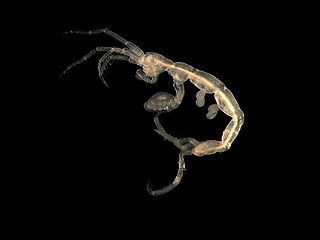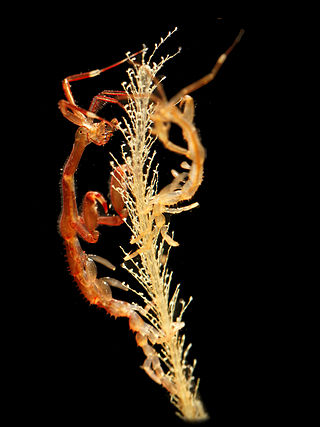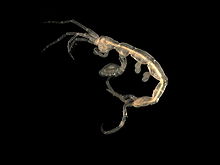
Amphipoda is an order of malacostracan crustaceans with no carapace and generally with laterally compressed bodies. Amphipods range in size from 1 to 340 millimetres and are mostly detritivores or scavengers. There are more than 9,900 amphipod species so far described. They are mostly marine animals, but are found in almost all aquatic environments. Some 1,900 species live in fresh water, and the order also includes the terrestrial sandhoppers such as Talitrus saltator and Arcitalitrus sylvaticus.

Jassa is a genus of amphipods in the family Ischyroceridae, comprising the following species:

A whale louse is a crustacean of the family Cyamidae. Despite the name, it is not a true louse, but rather is related to the skeleton shrimp, most species of which are found in shallower waters. Whale lice are commensal external parasites, found in skin lesions, genital folds, nostrils and eyes of marine mammals of the order Cetacea. These include not only whales but also dolphins and porpoises.

Gammaridea is one of the suborders of the order Amphipoda, comprising small, shrimp-like crustaceans. Until recently, in a traditional classification, it encompassed about 7,275 (92%) of the 7,900 species of amphipods described by then, in approximately 1,000 genera, divided among around 125 families. That concept of Gammaridea included almost all freshwater amphipods, while most of the members still were marine.

Corophiida is an infraorder of amphipods that contains the two parvorders Caprellidira and Corophiidira.

Caprellidae is a family of amphipods commonly known as skeleton shrimps. Their common name denotes the threadlike slender body which allows them to virtually disappear among the fine filaments of seaweed, hydroids and bryozoans. They are sometimes also known as ghost shrimps.
Melphidippidae is a family of amphipods which rest upside-down and feed on particles of food suspended in the water. Three genera are recognised:

Podoceridae is a family of amphipods. It contains eight genera:

The Hyperiidea are a suborder of amphipods, small aquatic crustaceans. Unlike the other suborders of Amphipoda, hyperiids are exclusively marine and do not occur in fresh water. Hyperiids are distinguished by their large eyes and planktonic habitat. Most species of hyperiids are parasites or predators of salps and jellyfish in the plankton, although Themisto gaudichaudii and a few relatives are free-swimming predators of copepods and other small planktonic animals.

Caprella is a large genus of skeleton shrimps belonging to the subfamily Caprellinae of the family Caprellidae. It includes approximately 170 species. The genus was first established by Jean-Baptiste Lamarck in his great work Système des animaux sans vertèbres (1801) to describe Cancer linearis and Squilla ventricosa.

Caprella mutica, commonly known as the Japanese skeleton shrimp, is a species of skeleton shrimp. They are relatively large caprellids, reaching a maximum length of 50 mm (2.0 in). They are sexually dimorphic, with the males usually being much larger than the females. They are characterized by their "hairy" first and second thoracic segments and the rows of spines on their bodies. Body color ranges from green to red to blue, depending on the environment. They are omnivorous highly adaptable opportunistic feeders. In turn, they provide a valuable food source for fish, crabs, and other larger predators. They are usually found in dense colonies attached to submerged man-made structures, floating seaweed, and other organisms.

Corophiidira is a parvorder of marine amphipod crustaceans in the infraorder Corophiida. In a previous classification, this taxon was treated as an infraorder and was then itself called Corophiida.

Caprelloidea is a superfamily of marine crustaceans in the order Amphipoda. It includes "untypical" forms of amphipods, such as the skeleton shrimps (Caprellidae) and whale lice (Cyamidae). The group was formerly treated as one of the four amphipod suborders, Caprellidea, but has been moved down to the superfamily rank by Myers & Lowry after phylogenetic studies of the group, and is now contained in the infraorder Corophiida of the suborder Senticaudata. The group includes the following families.

Senticaudata is one of the four suborders of the crustacean order Amphipoda. It includes some 5000 species, which is more than 50% or the currently recognized amphipod diversity.

Caprella penantis is a species of skeleton shrimp in the family Caprellidae. It lives on the seabed in shallow water in many parts of the world. This species was first described in 1814 by the English zoologist William Elford Leach who named it Caprella penantis in honour of the Welsh naturalist Thomas Pennant. The type locality is Devon, England.

Ampithoidae is a family of amphipod crustaceans. The family has a worldwide distribution as algal dwellers. They commonly create tube-shaped nests on their host plants or algae which serve as both shelter and food. Young ampithoids develop from eggs to a larval stage within their mother's brood-pouch, formed by the appendages of her abdomen.

Caprella unica is a species of skeleton shrimp in the genus Caprella within the family Caprellidae. The larvae are plankton-like. They are relatively small, with two large and two small antennae. They only live in the sea, and are widely found in Cape Cod, Maine and Newfoundland.
Bougisia is a genus of plankton in the sub-order Hyperiidea – a type of so-called "hyperid" amphipoda. The genus Bougisia is the only subordinate taxon in the monotypic family Bougisidae. The genus Bougisia is also monotypic, being represented by the single species, Bougisia ornata. This species lives as plankton in tropical and sub-tropical salt water. Hyperiidea species normally have a physique that differs from other types of amphipod.

Maeridae is a family of marine amphipods, which was first described by Taudl Krapp-Schickel in 2008.














